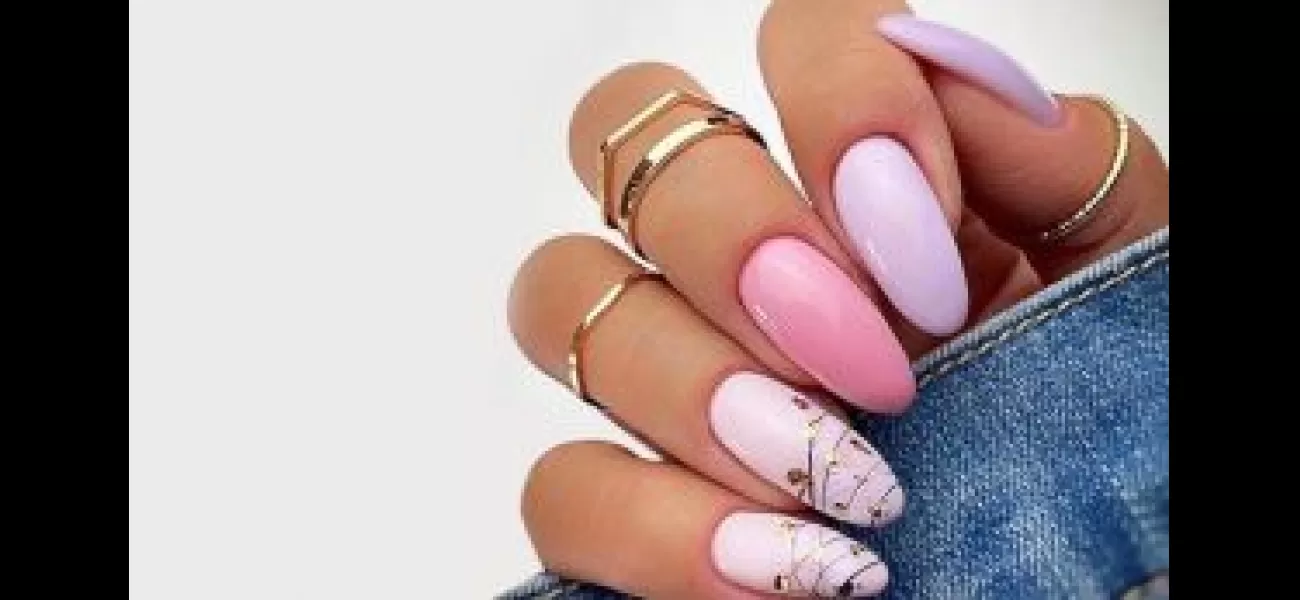Gel and acrylic nails are aesthetically pleasing, but they pose potential health hazards.
Celebs like Kylie Jenner and Ariana Grande are rocking long, embellished acrylic nails, making nail fashion a booming industry with gel and acrylics as top trends.
July 12th 2024.

In the world of fashion, it seems like everyone is trying to keep up with the latest trends. From Kylie Jenner and Rihanna to Ariana Grande and Cardi B, celebrities are flaunting long, acrylic nails adorned with intricate nail art as a way to express their personal style. As a result, the nail fashion industry is booming, with gel manicures and acrylic nails being among the most popular trends at the moment. While getting a manicure may feel like a luxurious act of self-care, it's important to recognize that it can actually have negative effects on our natural nails and even our overall health.
One of the main concerns with manicures is the nail glue used to attach acrylics to the natural nail. This glue is typically made up of a mixture of alcohol, cyanoacrylate, and photo-bonded methacrylate, along with other ingredients such as formaldehyde, which is a known carcinogen. These chemicals can cause irritation and even dermatitis, resulting in painful burns that have been widely reported. In some cases, the glue has even burned through clothing and caused damage to the skin underneath, leading to infections.
In addition, prolonged use of gels and acrylics can also lead to a condition called pseudo-psoriatic nails, where extra skin grows under the nail, giving it a red and crusty appearance similar to psoriasis. Interestingly, many people with this condition test positive for an allergy to methyl methacrylate, a common ingredient in nail adhesives. In severe cases, this allergy can even result in the permanent loss of fingernails, while others may experience tingling or numbness in their fingers due to peripheral neuropathy.
But the dangers of manicures don't stop there. While there are many factors that contribute to the risk of cancer, there have been cases where UV nail lamps used to cure gel nails have been linked to skin cancer. These dryers emit UVA light, which hardens the gel, but also increases our exposure to UV radiation. Since most people get their nails done every few weeks, this can significantly increase our UVA exposure, especially since the back of our hands are often unprotected from the sun.
Furthermore, the removal process for both gel and acrylic manicures can also cause damage to our natural nails. Even the most careful removal can result in weakening and brittleness of the nail, as well as changes to the capillaries underneath. This can lead to a condition called traumatic onycholysis, where the nail is pulled away from the bed underneath, creating a rollercoaster-like appearance. In some cases, this can also open up the barrier that protects our body from the outside world, making us more susceptible to infections like paronychia.
Leaving false nails on for too long can also create a moist environment underneath the nail, making it a breeding ground for fungus. This can go unnoticed as the acrylic hides any changes to the appearance of the natural nail, allowing the infection to progress without being noticed. Even traditional nail varnish is not without its risks, as it can alter pulse oximeter readings, which measure the amount of oxygen in our blood. In clinical settings, gels, acrylics, and varnish are often banned due to the risk of bacteria breeding under the nails and being passed between staff and patients.
So, what can we do to protect ourselves while still enjoying manicures? Instead of opting for gels and acrylics, it may be better to focus on caring for our natural nails and leaving them visible so we can notice any changes that may indicate health issues, such as fungal infections or even heart disease. And if you do decide to get a manicure, make sure to reduce your risk of UV exposure by applying sunscreen beforehand and wearing dark, fingerless gloves during the appointment. Our nails may be a small part of our body, but they can offer valuable insights into our overall health.
One of the main concerns with manicures is the nail glue used to attach acrylics to the natural nail. This glue is typically made up of a mixture of alcohol, cyanoacrylate, and photo-bonded methacrylate, along with other ingredients such as formaldehyde, which is a known carcinogen. These chemicals can cause irritation and even dermatitis, resulting in painful burns that have been widely reported. In some cases, the glue has even burned through clothing and caused damage to the skin underneath, leading to infections.
In addition, prolonged use of gels and acrylics can also lead to a condition called pseudo-psoriatic nails, where extra skin grows under the nail, giving it a red and crusty appearance similar to psoriasis. Interestingly, many people with this condition test positive for an allergy to methyl methacrylate, a common ingredient in nail adhesives. In severe cases, this allergy can even result in the permanent loss of fingernails, while others may experience tingling or numbness in their fingers due to peripheral neuropathy.
But the dangers of manicures don't stop there. While there are many factors that contribute to the risk of cancer, there have been cases where UV nail lamps used to cure gel nails have been linked to skin cancer. These dryers emit UVA light, which hardens the gel, but also increases our exposure to UV radiation. Since most people get their nails done every few weeks, this can significantly increase our UVA exposure, especially since the back of our hands are often unprotected from the sun.
Furthermore, the removal process for both gel and acrylic manicures can also cause damage to our natural nails. Even the most careful removal can result in weakening and brittleness of the nail, as well as changes to the capillaries underneath. This can lead to a condition called traumatic onycholysis, where the nail is pulled away from the bed underneath, creating a rollercoaster-like appearance. In some cases, this can also open up the barrier that protects our body from the outside world, making us more susceptible to infections like paronychia.
Leaving false nails on for too long can also create a moist environment underneath the nail, making it a breeding ground for fungus. This can go unnoticed as the acrylic hides any changes to the appearance of the natural nail, allowing the infection to progress without being noticed. Even traditional nail varnish is not without its risks, as it can alter pulse oximeter readings, which measure the amount of oxygen in our blood. In clinical settings, gels, acrylics, and varnish are often banned due to the risk of bacteria breeding under the nails and being passed between staff and patients.
So, what can we do to protect ourselves while still enjoying manicures? Instead of opting for gels and acrylics, it may be better to focus on caring for our natural nails and leaving them visible so we can notice any changes that may indicate health issues, such as fungal infections or even heart disease. And if you do decide to get a manicure, make sure to reduce your risk of UV exposure by applying sunscreen beforehand and wearing dark, fingerless gloves during the appointment. Our nails may be a small part of our body, but they can offer valuable insights into our overall health.
[This article has been trending online recently and has been generated with AI. Your feed is customized.]
[Generative AI is experimental.]
0
0
Submit Comment





